PROJECT ANNOUNCEMENTS
Combustion
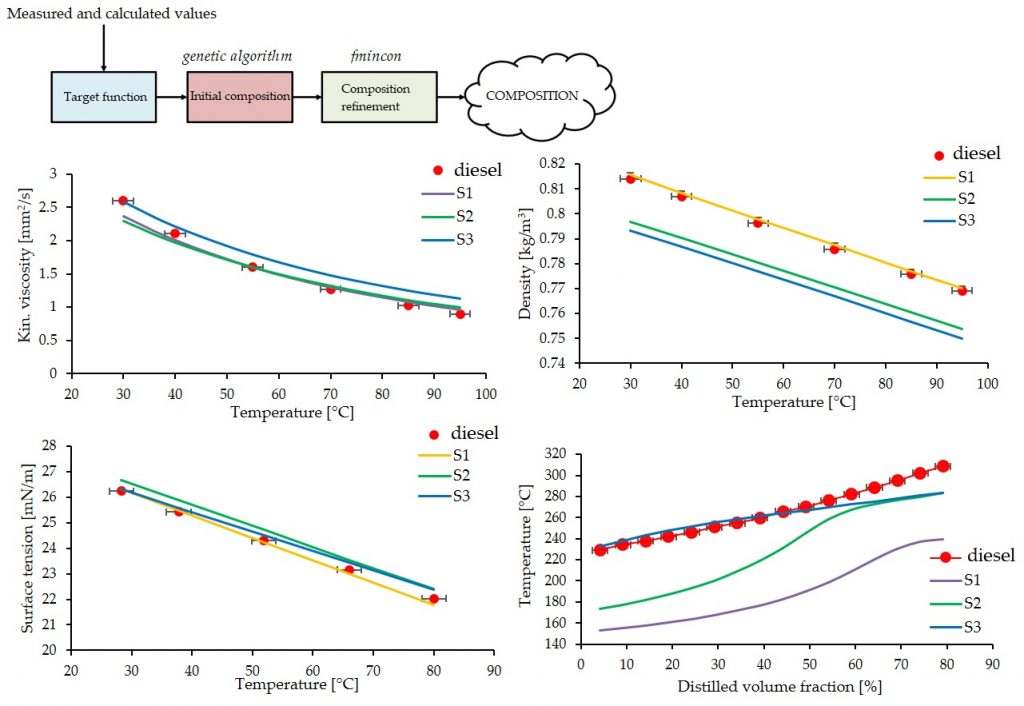
Optimization of surrogate fuel composition for numerical heat and mass transfer analysis
Supervisor: Dávid Csemány
Commercially used liquid fuels typically have a high number of components. This encumbers the implementation of liquid fuels into modeling environments for burner design and combustion simulations. Surrogate fuel possesses physical and chemical properties identical to the real fuel, however, it contains significantly fewer components, enabling practical application. In this project, the composition of the surrogate mixture is optimized according to measured and calculated material properties of the investigated fuel sample regarding the original composition. The objective is to determine a surrogate mixture composed of a few components but following the thermophysical properties of the real fuel sample to model atomization, evaporation, and heat release related phenomena.
Reference:
Huang Z, Xia J, Ju D, Lu X, Han D, Qiao X, et al. A six-component surrogate of diesel from direct coal liquefaction for spray analysis. Fuel 2018;234:1259–68. doi: https://doi.org/10.1016/j.fuel.2018.07.138
Experimental investigation on material properties of renewable liquid fuels
Supervisor: Dávid Csemány
Thermophysical properties of liquid fuels significantly affect heat and mass transfer before the flame front and chemical reactions in the combustion chamber. Information on material properties is crucial for burner design and in case of fuel change for operating heat engines. However, reliable reference data on a broad parameter range is scarce in the literature, especially for renewable fuels. In this project, different fuel samples are investigated with standardized methods. The measured properties are density, kinematic viscosity, surface tension, atmospheric distillation curve, and flash point.
Hidegh G, Csemány D, Vámos J, Kavas L, Józsa V. Mixture Temperature-Controlled combustion of different biodiesels and conventional fuels. Energy 2021;234:121219. doi: https://doi.org/10.1016/j.energy.2021.121219
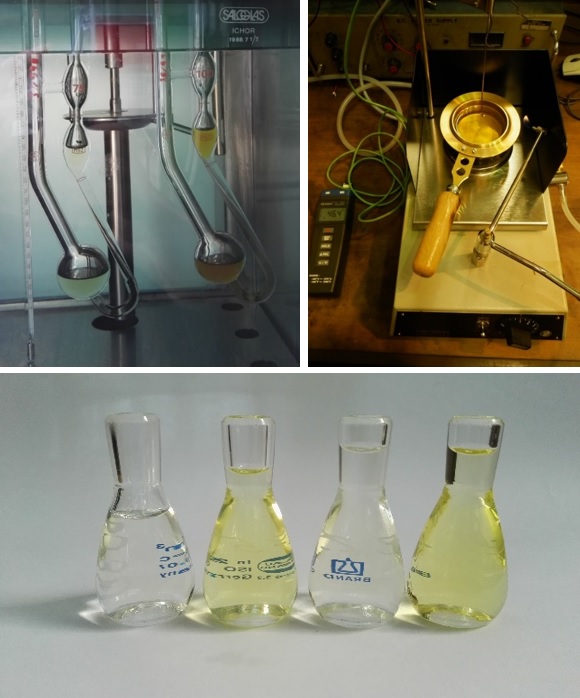
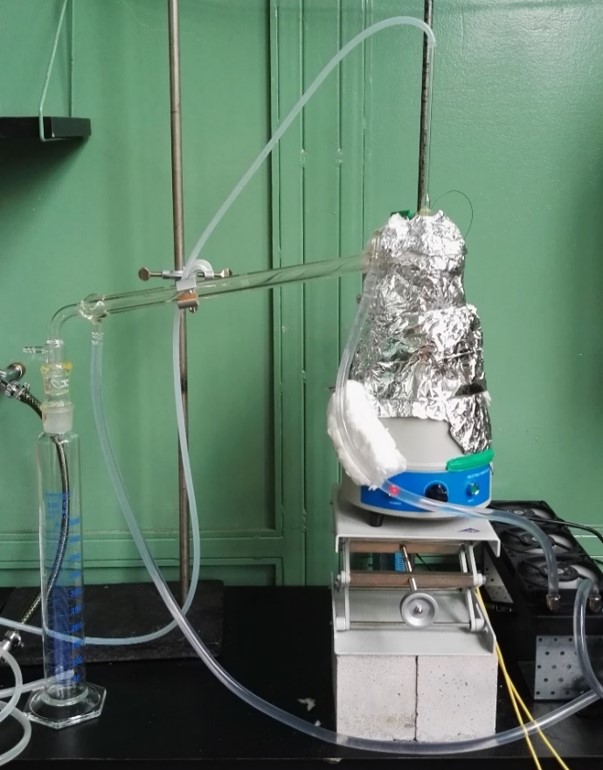
Experimental investigation of the volatility characteristics of multicomponent liquid fuels
Supervisor: Dávid Csemány
Volatility characteristics of liquid fuels affect the geometry and operating parameters for burner design and operation. Droplets in fuel spray have to evaporate and mix with combustion air before reaching the flame front in premixed burners. Atmospheric distillation curve can characterize volatility properties. In this project, the volatility characteristics of different fuel samples are measured and evaluated with a modified atmospheric distillation apparatus. Renewable fuels and conventional fuels blended with renewables are investigated.
Reference:
Ferris AM, Rothamer DA. Methodology for the experimental measurement of vapor–liquid equilibrium distillation curves using a modified ASTM D86 setup. Fuel 2016;182:467–79. doi: https://doi.org/10.1016/j.fuel.2016.05.099
Evaluation of material property estimating methods for liquid fuels
Supervisor: Dávid Csemány
Reliable material property databases on a broad parameter range for liquid fuels are scarce in the literature, especially for alternative fuels. Estimating methods can be applied if no measurement data is available. However, their accuracy is often unknown for the investigated materials. In this project, estimating methods for thermophysical properties affecting heat and mass transfer and atomization characteristics are compared to reference data. The evaluation can highlight the applicability of the models for the different fuel types.
Reference:
Csemány D, Gujás I, Chong CT, Józsa V. Evaluation of material property estimating methods for n-alkanes, 1-alcohols, and methyl esters for droplet evaporation calculations. Heat Mass Transf 2021. doi: https://doi.org/10.1007/s00231-021-03059-0
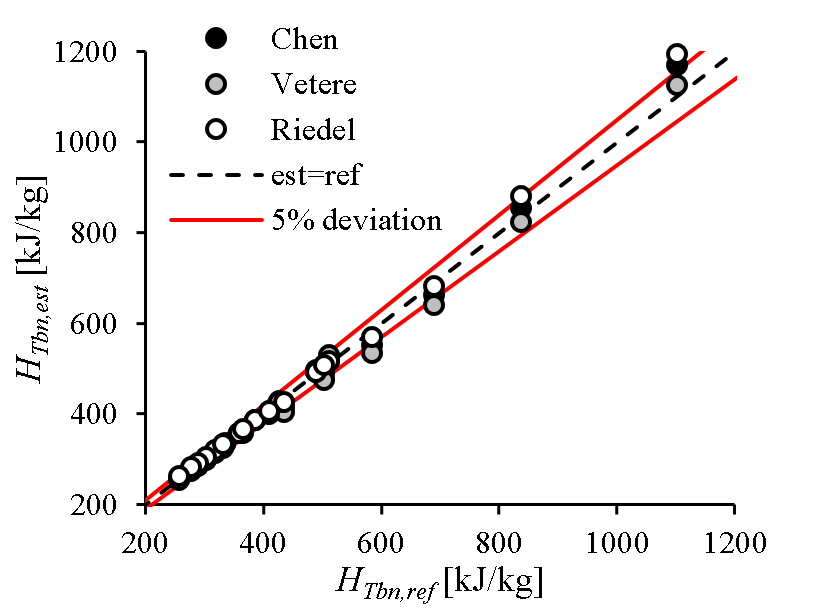
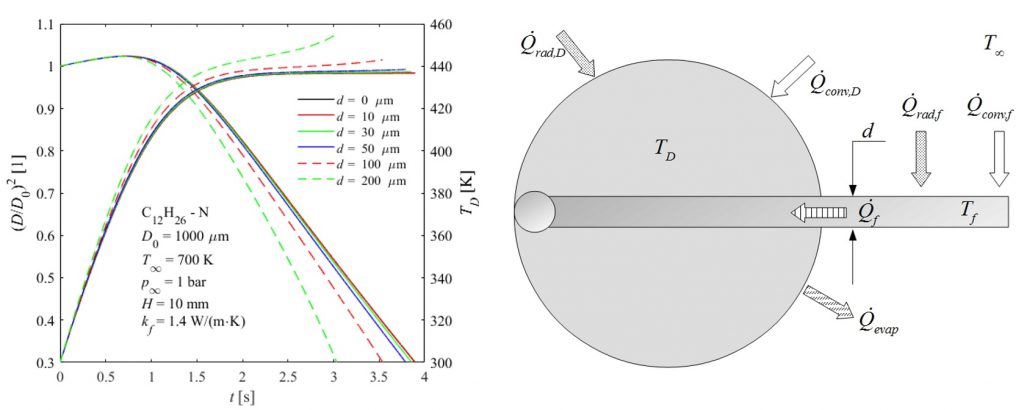
Numerical modelling of single droplet evaporation
Supervisor: Dávid Csemány
The single droplet measurement method is usually applied for the measurement of liquid fuel evaporation instead of investigating the whole spray. In this method, the droplet is suspended to a thin fiber. However, this measurement method has several biases and uncertainties affecting the intensity of vaporization. In this project, one-dimensional numerical modeling is performed with the finite difference method. The objective is to identify parameters of the measurement which can minimize the bias on droplet evaporation.
Reference:
Csemány D, Józsa V. Uncertainty of droplet evaporation measurements and its effect on model validation. In: Costa M, Rabaçal M, Fernandes E, Pires J, Coelho P, editors. Proc. 9th Eur. Combust. Meet., Lisbon: 2019, p. 6.
Evaluation of spray evaporation in a swirl burner
Supervisor: Józsa Viktor
Evaporation of liquid droplets can be found in several applications, from which liquid fuel combustion is one of them. The spray measurement should be performed without disturbing the flow due to the small sizes (micrometer range). From the optical techniques, the most suitable one is the Phase Doppler Anemometer, which was used for performing measurements at characteristic points of the spray in the combustion test system of our department. The project goal is processing the measurement data and characterizing spray evaporation. The recommended software environment for the project is matlab, in which we have pre-written codes; there is no need for previous software knowledge.
Reference:
Lefebvre AH, McDonell VG. Atomization and Sprays. Second. Boca Raton, FL, FL: CRC Press; 2017.
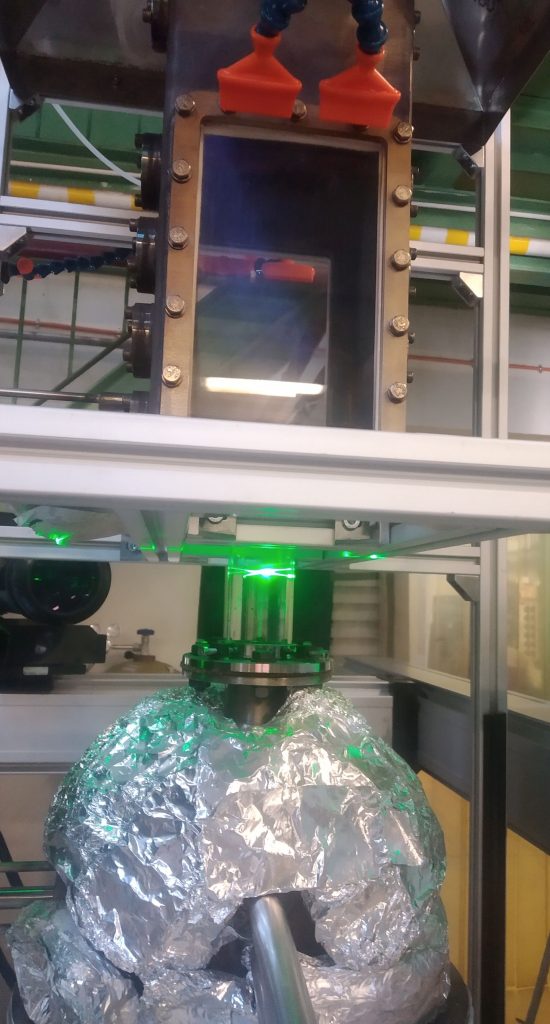
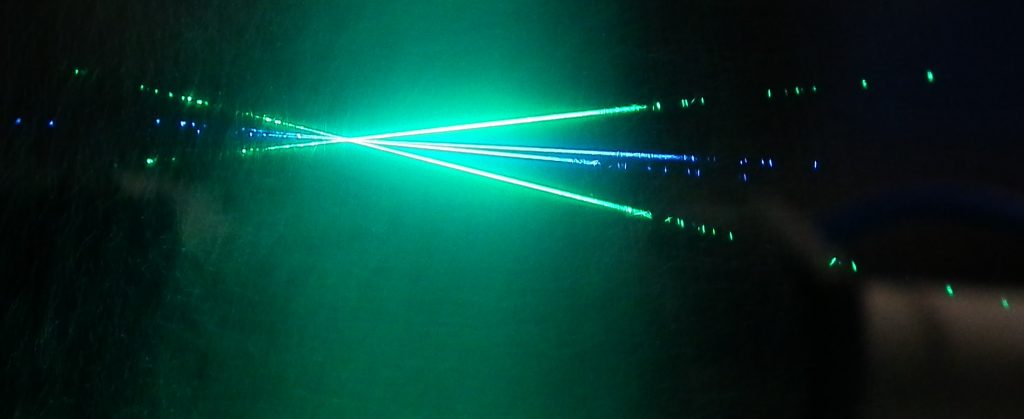
Characterization of velocity distribution of high-velocity atomization using non-dimensional numbers
Supervisor: Józsa Viktor
High-velocity atomization is present in numerous fields, from medicine to combustion. The characterization of spray is often performed by using empirical formulas and thumb rules. A previously measured, comprehensive Phase Doppler Anemometer database will be evaluated during the project. From the non-dimensional numbers, principally, Reynolds and Stokes numbers can be used to characterize droplet motion. The goal of the project is the determination of the gas phase velocity, which can be estimated only by using the entrained droplet data. The recommended software environment for the project is matlab, in which we have pre-written codes; there is no need for previous software knowledge.
Reference:
Urbán A, Malý M, Józsa V, Jedelský J. Effect of liquid preheating on high-velocity airblast atomization: From water to crude rapeseed oil. Exp Therm Fluid Sci 2019;102:137–51. doi: https://doi.org/10.1016/j.expthermflusci.2018.11.006
Comparison of the evaporation of various fuels in a swirl burner
Supervisor: Józsa Viktor
The will to reduce our dependence on fossil fuels is continuously intensified, however, there is no current alternative for conventional motors for numerous industries. To mitigate the situation, various alternative fuels have emerged, which show notably different both physical and chemical behaviors. During this project work, measured Phase Doppler Anemometer data sets of fuels with various volatility are compared. The recommended software environment for the project is matlab, in which we have pre-written codes; there is no need for previous software knowledge.
Reference:
Hidegh G, Csemány D, Vámos J, Kavas L, Józsa V. Mixture Temperature-Controlled combustion of different biodiesels and conventional fuels. Energy 2021;234. doi: https://doi.org/10.1016/j.energy.2021.121219
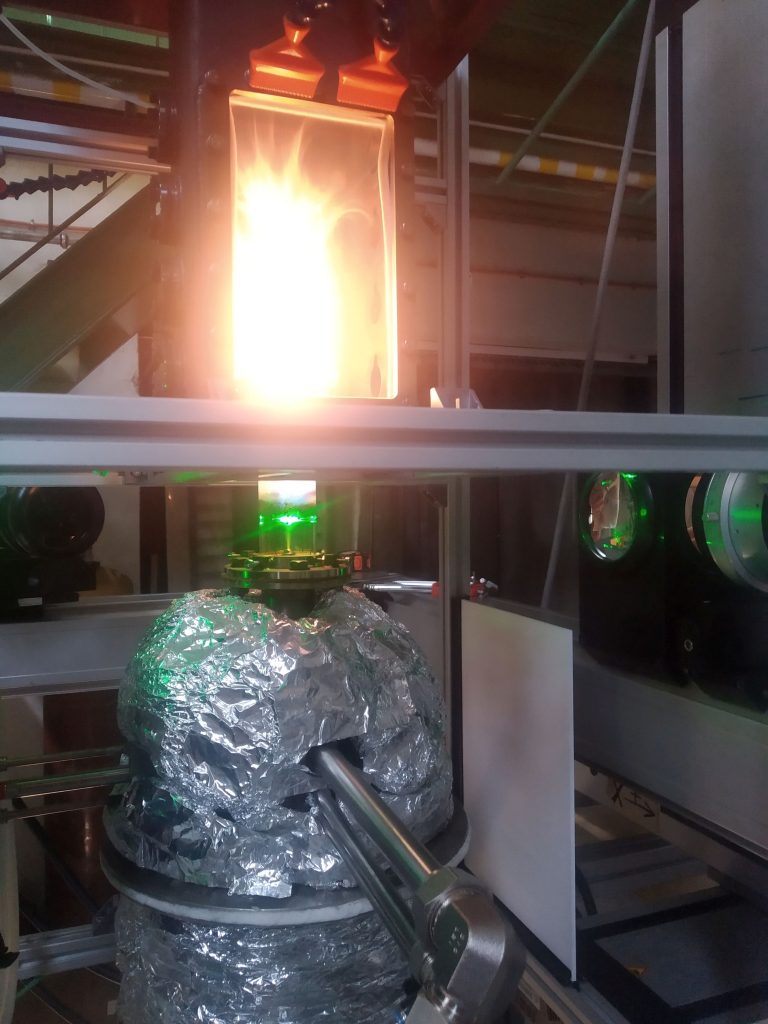

Evaluation of natural gas combustion by high-speed Schlieren technique
Supervisor: Józsa Viktor
Natural gas utilization will evidently determine our current century since it has the lowest specific CO2 emission among fossil fuels. In combustion, we use swirl burners for low emissions. Our team has performed a series of high-speed Schlieren imaging measurements on such a burner. The aim of the project is to characterize the flame by image processing at various setups. The recommended software environment for the project is matlab, in which we have pre-written codes; there is no need for previous software knowledge.
Reference:
Lefebvre AH, Ballal DR. Gas turbine combustion. third. Boca Raton: CRC Press; 2010. doi: https://doi.org/10.1002/1521-3773
Evaluation of various flame shapes by high-speed Schlieren technique
Supervisor: Józsa Viktor
Pollutant emissions are strongly affected by the flame shape in combustion systems, which is determined by the local mixture quality. The most favorable state is distributed combustion when the fuel is almost perfectly mixed with air before ignition. The new combustion concept, developed at our department, allows this, which is the subject of the present project proposal. The goal is the comparison of this with other stable flame shapes by processing available high-speed Schlieren images. The recommended software environment for the project is matlab, in which we have pre-written codes; there is no need for previous software knowledge.
Reference:
V. Józsa, “Mixture temperature-controlled combustion: A revolutionary concept for ultra-low NOx emission,” Fuel, vol. 291, no. May, p. 120200, May 2021, https://doi.org/10.1016/j.fuel.2021.120200
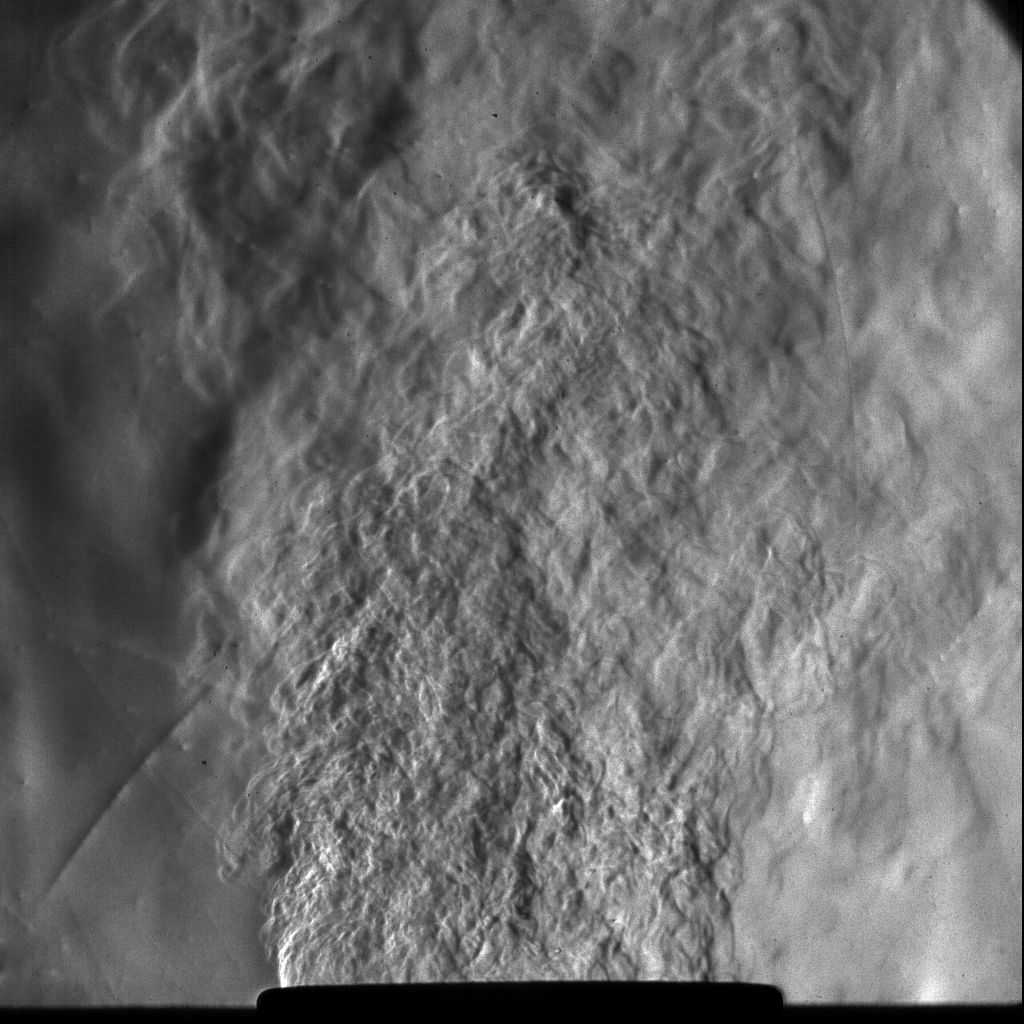
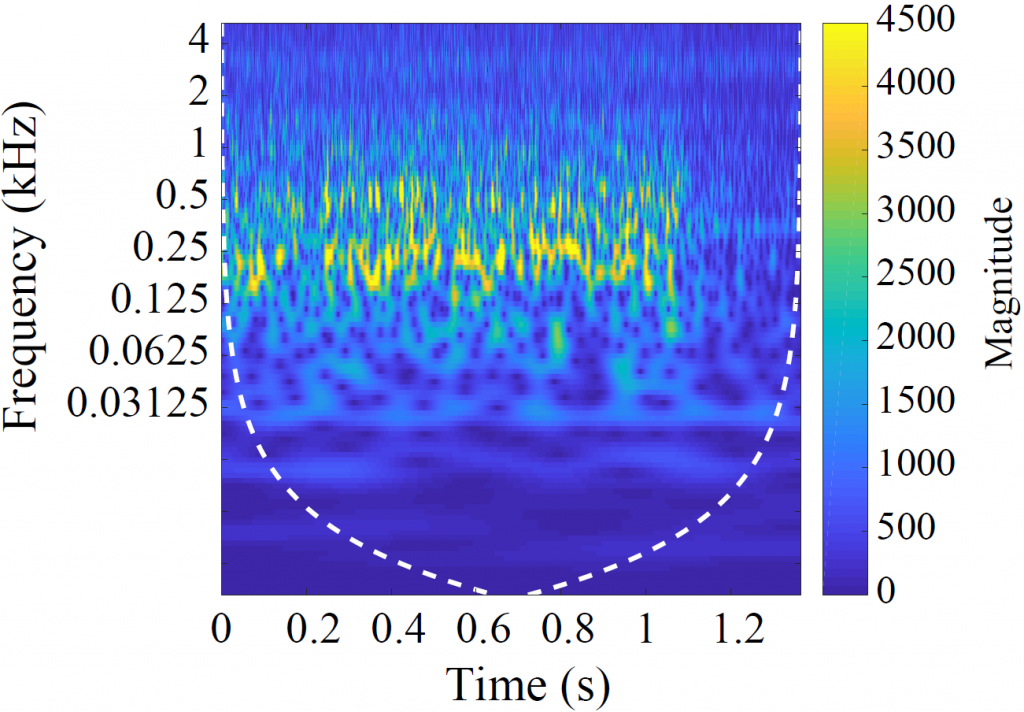
Spectral analysis of a turbulent flame based on Schlieren imaging technique
Supervisor: Józsa Viktor
The fluctuation of turbulent flames may damage the combustion chamber in unfavorable cases, and may lead to complete destruction in extreme situations. To prevent these events, the spectra of combustion noise and the heat realease are commonly evaluated. The aim of this project is to analyze flame regions by Fourier transform based on available high-speed Schlieren images. The recommended software environment for the project is matlab, in which we have pre-written codes; there is no need for previous software knowledge.
Reference:
S. Candel, D. Durox, T. Schuller, J.-F. Bourgouin, and J. P. Moeck, “Dynamics of Swirling Flames,” Annu. Rev. Fluid Mech., vol. 46, no. 1, pp. 147–173, 2014, https://doi.org/10.1146/annurev-fluid-010313-141300
Thermodynamic modeling
Development of Cycle Tempo thermodynamic performance monitoring software in Fortran/Matlab environment
Supervisor: Groniewsky Axel
Cycle Tempo is a software for modelling thermodynamic processes and systems. The task is to create an add-in to the software. (http://www.asimptote.nl/software/cycle-tempo/)
Development of a working fluid selection mechanism based on artificial neural network (ANN) for a given organic rankine cycle (ORC)
Supervisor: Groniewsky Axel
Development of a thermodynamic model of an ORC operating under given temperature limits with different working fluids; neural network is trained on these results; efficiency is estimated.
Development of a Machine Learning (ML) based (Random forest, k-mean clastering) working fluid selection mechanism for existing Organic Rankine Cycle
Supervisor: Groniewsky Axel
Designing a thermodynamic model of an ORC operating within given temperature limits for various working fluids; processing results using Machine Learning techniques that allow estimating the influence of parameters affecting the results.
Prediction of power plant behaviour using neural networks
Supervisor: Groniewsky Axel
Estimation of the physical properties of pure substances using Group-Contribution method.
Supervisor: Groniewsky Axel
Sensitivity analysis of the parameters of the PC-Saft equation of state in the light of the behaviour of Organic Rankine Cycles (ORC)
Supervisor: Groniewsky Axel
PC-SAFT equation of state: a model based on statistical thermodynamics that is suitable for estimating the physical properties and phase equilibrium of multicomponent fluids based on the number of segments in a chain, diameter of segments, and dispersion energy of interaction between segments.
Design of energy systems in Cycle Tempo thermodynamic performance monitoring software environment
Supervisor: Groniewsky Axel
Designing the thermodynamic model of a complex energy system using historical or literature data.
Design of energy systems in Gate Cycle thermodynamic performance monitoring software environment
Supervisor: Groniewsky Axel
Designing the thermodynamic model of a complex energy system using historical or literature data.
Numerical exploitation of the Kirchhoff transformation
Supervisor: Mátyás Szücs
When solving heat conduction problems in the engineerign practice usually material coefficients are treated as constant, however, in many cases (for “large” temperature differences) this approximation is not correct, the temperature dependence
of the coefficients have to be taken into account. Then (when the material coefficients are temperature dependent) solution of the heat conduction equation is not self-evident. The Kirchhoff transformation offers an opportunity for this.
Finding analytical solutions for the transformed equation is also complicated, but the method is numerically easy to apply.
The task is to develop, test and demonstrate the application of the method on heat conduction problems in one and/or more spatial dimensions.
Reference:
https://en.wikipedia.org/wiki/Thermal_simulations_for_integrated_circuits
Numerical investigation of fins in three spatial dimensions
Supervisor: Mátyás Szücs
Usually in the technical practices, proper cooling of a component (e.g., processors) is accomplished by the usage of ribs. When designing the ribs, the calculations are usually done in one spatial dimension, however, the conditions of the validity of this approximation is not self-evident. Via non-dimensionalizing the one and three spatial dimensional equations the important parameters (which characterize the solution) are revealed. Through the examination of these parameters geometrical and physical conditions can be obtained that characterize the scope of one-dimensional modeling. The task is the numerical modeling of fins with different shapes and specifying the necessary conditions.
Investigation and comparison of numerical methods on the example of an undamped vibratory system
Supervisor: Mátyás Szücs
Due to complexity and difficulty of physical phenomena, analytical solutions can be produced to a limited region of models, thus in most cases numerical methods are applied. Numerical solution methods are burdened by a number of errors, e.g., such a typical error is
the dissipation (artificial damping) error. This error is already present when simulating reversible and non-dissipative systems, thus in case of the simulation of an irreversible and dissipative system the physical and numerical damping are indistinguishable.
Within the framework of the task, the examination of a vibratory system with several (but finite) degrees of freedom must be performed by several traditional and symplectic numerical methods.
A feladat keretein belül egy több (de véges) szabadsági fokú rezgőrendszer vizsgálatát kell elvégezni számos hagyományos és szimplektikus numerikus módszer segítségével. A feladat kimenete a módszerek pontosság, numerikus összimpulzus- és összenergiaőrzés, valamint stabilitás szempontjából történő osztályozása.
Reference:
https://en.wikipedia.org/wiki/List_of_Runge-Kutta_methods
Heat conduction in the supercritical region
Supervisor: Mátyás Szücs
Material properties (such as isobar specific heat capacity, coefficients of thermal expansion and compressibility) changes significantly for small temperature change in an enviromnent of the critical point. Due to this sudden change of the coefficient of thermal expansion a pressure wave develops in the material, which also transports thermal energy, thus apparently the propagation of temperature with the speed of sound is observed. The literature describes this phenomenon as “Piston”-effect, which is mentioned by many works as the fourth mode of heat propagation, although the phenomenon is merely a result of thermal-mechanical coupling. This phenomenon is measured on sulfur hexafluoride in space with microgravity conditions, however, velocity field was assumed to be zero in the evaluation, as a consequence, the pressure field is homogeneous, thus the model does not take pressure waves into account. The task is to reproduce models known from the literature as well as compare them to the model, which takes flow phenomenon into account.
Numerical investigation of a thermodynamically compatible visco-elasto-plastic model of solids
Supervisor: Mátyás Szücs
Many solids exhibit behavior other than elasticity. While according to Hooke's Law, there is an algebraic relationship between stress and strain, in the case of rheological/viscoelastic models this relationship is described via a temporal differential equation, and plastic changes results in permanent stress or strain in the unloaded end state. In case of rocks, the former processes take place simultaneously, thus all these must be taken into account when measuring and fitting material parameters. A general distinguished visco-elastic-plastic material model is derived via internal variable methodology of thermodynamics, which contains several traditional rheological and plastic models, moreover, it offers more opportunities that have not been investigated so far. The task is the numerical modeling of a uniaxial tensile experiment and investigation of this thermodynamically compatible visco-elasto-plastic material model.
Investigation and comparison of thermodynamical state equations
Supervisor: Mátyás Szücs
An essential part of thermodynamic modeling is the description of material properties. For liquid-gas systems several different equations of state are known. The task is to construct different phase diagrams (e.g., p-v, T-s, p-T, etc.) for some equations of state (e.g., Van der Waals, Berthelot, Redlich--Kwong, etc.), and to calculate and investigate the material properties (such as specific heat capacities, coefficients of thermal expansion and compressibility, etc.). The investigated models have to be compared to measured data, too. The solution of the task is performed in the Python language by using symbolic module.
Dissipation in viscoelastic solid media - the effect of wave propagation
Supervisor: Fülöp Tamás
For mechanical modelling of loading of solid bodies, it is frequently satisfactory to use the force equilibrial / quasistatic approximation, when we omit the acceleration related term in the mechanical equation of motion (the Cauchy equation). Thereby, we neglect the fast transients and waves. This is usually enough to be in agreement with the measured stress, strain and displacement values, while both the analytical solution of the equations is simpler and the time step needed for the numerical solution can also be much larger. However, in such experiments, monitoring temperature is also informative, and dissipation of mechanical energy manifests itself as heat so a question is whether the force equilibrial approximation describes dissipation also satisfactorily. The task is numerical investigation in a one-dimensional sample with Poynting-Thomson-Zener rheology: how different is the dissipation predicted by the model including wave propagation from the prediction of the force equilibrial model?
Analytical investigation of signal propagation in rheological solids
Supervisor: Fülöp Tamás
In elastic solid media, wave number is proportional to frequency so signals of any shape have the same propagation speed. In viscoelastic/rheological media, the relationship between wave number and frequency is more complicated, hence, wave propagation speed depends on the shape of the signal. A related numerical investigation is presented in the enclosed background material. However, numerical solutions have their limitations: for explicit methods, the Courant number gives a limitation while an implicit solver may represent the relationship between wave number and frequency in a considerably distorted way. he task is analytical investigation of the propagation of the signal shape considered in the enclosed background material.
Analytical formulae for the flash experiment in heat conduction
Supervisor: Fülöp Tamás
One way of measuring thermal conductivity is via the flash experiment. We apply a flash of light on a sample, and determine thermal conductivity (knowing the sample size, density and specific heat) from the raise history of temperature at the opposite side using an approximate analytical formula. In case of heterogeneous (either naturally or artificially heterogeneous) samples, a model more complicated than Fourier heat conduction is needed. During such evaluations of experiments, we have found that formula (8) of the enclosed background material is approximately fulfilled. The task is to justify this formula via approximate analytical calculation.
Reference:
https://arxiv.org/pdf/2102.11744
Generalized symplectic simulation of a damped spring pendulum
Supervisor: Fülöp Tamás
The Runge-Kutta and other classic numerical methods gradually destroy the energy conservation of a simulated mechanical system. On the other side, the so-called symplectic numerical methods preserve energy conservation for even very large times. For dissipative mechanical systems it is also important to avoid numerics-caused artificial dissipation of energy in order to obtain the true thermodynamical dissipation. The generalization of symplectic methods to dissipative systems is, in recent years, an intensively developing research area. The task is to apply such generalized methods on a damped spring pendulum.
Reference:
https://en.wikipedia.org/wiki/Symplectic_integrator
Substituting a pulse boundary condition by a pulse initial condition in beyond-Fourier heat conduction
Supervisor: Fülöp Tamás
In Fourier's heat conduction model, a pulse-like excitation of a boundary of a one-dimensional sample (a heat current density that is Dirac delta-like in time) can basically be replaced by a Dirac delta-like initial temperature distribution concentrated at the boundary. So to say, we consider the sample right after the excitation so the entered internal energy has already warmed the part near the boundary but has not yet started to spread towards the inner part of the sample. Replacing the boundary condition with an initial one may simplify and speed up the numerical solution. The task is to test the analogous conjecture for the Guyer-Krumhansl (GK) heat conduction model, via a finite difference numerical method. In the GK heat conduction equation (which is applicable for many heterogeneous samples), second time derivative of temperature and time derivative of the second spatial derivative also appear.
Optimization of a finite difference scheme in the example of heat conduction in a disk
Supervisor: Fülöp Tamás
Discretization of spatial derivatives is easy in a rectangular coordinate system. In a curvilinear one, however, it is nontrivial. The model behind the equation to discretize suggests some natural-looking choice but this suggestion is to be tested. The task is to compare a number of choices, in the example of Fourier heat conduction in a disk. The last section of the enclosed background material sheds some light on the task.
Reference:
https://www.dropbox.com/s/rwiw071f4tzdp85/04-ppde-200507.ipynb?dl=0
Renewables
Modeling and optimization of hybrid renewable energy systems
Supervisor: Mayer Martin János
The hybrid renewable energy systems use a set of different energy generators and storage methods to cover the electricity and heat demands. The modeling of these systems requires separate models to describe each renewable producer, the energy demand profiles, storage systems and possibly heat pumps; and carries the opportunity of a complex global optimization. Within this general framework, the evaluation of this topic can be focused on one specific component or technology, to answer such questions as: 1) What is the potential of utilizing the thermal inertia of a building? 2) What are the effects of different electricity profiles on the sizing and profitability of the system? 3) Which energy storage technologies fit the best for the given demands and producers?
Mayer Martin János, Szilágyi Artúr, Gróf Gyula: Environmental and economic multi-objective optimization of a household level hybrid renewable energy system by genetic algorithm. Applied Energy 269: 115058, 2020. doi: https://doi.org/10.1016/j.apenergy.2020.115058
Development of photovoltaic power forecasting methods
Supervisor: Mayer Martin János
Forecasting the power production of photovoltaic systems is crucial for their effective grid integration. The forecasts can be created by either physical or statistical, data-driven machine learning methods, or even with their hybridization. In terms of temporal horizon, intra-hour, intraday and day-ahead horizons can be classified, each having their specific input data such as the actual power output, satellite images and numerical weather prediction, respectively. Forecasts can be either deterministic or probabilistic, which latter also carries information about the uncertainty of the forecasts. The evaluation of this topic can focus, based on the individual interest, on any selected forecast goals, and the time horizon and the applied method are selected accordingly.
Reference:
Mayer Martin János, Gróf Gyula: Extensive comparison of physical models for photovoltaic power forecasting. Applied Energy 283: 116239, 2021. doi: https://doi.org/10.1016/j.apenergy.2020.116239
Energy forecasting with machine learning methods
Supervisor: Mayer Martin János
The main fields of energy forecasting are load, wind and solar power, imbalance, and price forecasting, all of which are important for the efficient operation of the electricity network and maximizing the revenues of the market participants. The most commonly used method for forecasting is machine learning, which can learn the relationship between the inputs and outputs from on historical data. The accuracy of the forecasts is influenced by the selection of the predictor variables, the machine learning model and the selection of the hyperparameters. The evaluation of this topic can focus on any aforementioned goals, and the forecasting method is selected based on personal preferences and the available data.
Applications of energy storage systems for weather-dependent renewable energy production
Supervisor: Mayer Martin János
Weather-dependent renewable energy sources are not suitable to directly fulfill the energy needs due to their intermittent nature. The variability of renewable production is still mostly balanced by fossil fuel power plants, but role of energy storage systems is expected to increase in the near future. Energy storage can be used for balancing the errors of power forecasts and thereby reduce the imbalance penalties, for shifting the renewable production to the peak load times even on a daily or seasonal timescale, and for other innovative means that support the operation of the grid. The evaluation of the topic can focus on either deeper modeling of a single storage technology, or on the cooperation of multiple storage systems to fulfill a complex storage goal.
Analysis of the optimal energy mix of the future
Supervisor: Mayer Martin János
Increasing the share of renewable energy sources is the main element of most energy strategies created today. However, the optimal future energy mix can only be simulated based on the hourly time-series data of the expected load and generation profiles. Such simulation can not only aim to find the optimal share of different energy sources, but also the optimal design parameters of the power plants, e.g. the tilt angle of photovoltaic systems. The results can serve as a basis for recommendations on the newly installed power plants, and they can also reveal the time periods in the future when renewable energy surplus can be expected, which is important information for sizing storage systems and estimating the environmental impacts of electricity production.
Ammonia as an internal combustion engine fuel
Supervisor: Bereczky Ákos
- Overview of ammonia use options
- Development of a measurement system and measurement plan for the tests
- Summary of results
Hydrogen technology in the waterborne transport sector
Supervisor: Bereczky Ákos
Life cycle assessment
Life-cycle assessment of household level power generation systems
Supervisor: Artúr Szilágyi
Life-cycle assessment of geothermal energy systems
Supervisor: Artúr Szilágyi
Life-cycle assessment of nuclear power
Supervisor: Artúr Szilágyi
Nuclear power pose an almost negligible environmental impact during normal operation. However, in terms of their entire life cycle (manufacturing, transportation, waste management, etc.) we find a number of significant environmental problems. The aim of the research is to quantify these indirect environmental impacts by presenting and evaluating one or more selected technologies from an environmental point of view.
Life-cycle assessment of municipal solid waste treatment technologies
Supervisor: Artúr Szilágyi
Analysis of municipal sustainable energy and climate action plans
Supervisor: Artúr Szilágyi
The Sustainable Energy and Climate Action Plan concept has been developed by the Covenant of Mayors. It is designed to give a detailed overview on the energy situation and GHG emissions of a municipality and defines quantifiable actions to reduce emissions, identify energy efficiency measures and adopt renewable energy targets. It also offers actions to adapt to climate change taking into account the risks that are relevant to the area such as floods or heat waves. Another goal is taking action to alleviate energy poverty. The aim of the research is to examine or compare the climate strategy of one or more settlements.
Ecodesign case study based on life-cycle assessment
Supervisor: Artúr Szilágyi
New methods for Estimating the Relaibility of Power Generating Systems
Supervisor: István András Fazekas
A feladat az Európai Bizottság Energiaügyi Főigazgatósága által kiadott „Identification of Appropriate Generation and System Adequacy Standards for the Electricity Market” dokumentumban javasolt eljárás hazai erőműrendszerre történő alkalmazása. Lényegében annak a kérdésnek a megválaszolása, hogy mi az optimális rendszerbővítési stratégia. A számítás középpontjában a LOLP számítás alkalmazása és a különböző célú rendszerszabályozási tartalékok valószínűségelméleti meghatározása áll.
Impact of connecting wheather-dependent electricity generating units to the controllable power system operation
Supervisor: István András Fazekas
In the framework of the task will be detailed analysed the impact of connecting weather-dependent electricity generating units to the controllalble power system operation.
The main drivers of global CO2-emission from fossile fuels
Supervisor: István András Fazekas
In the framework of the task the main drivers of the global CO2-emission will be analysed based on time series analysis.